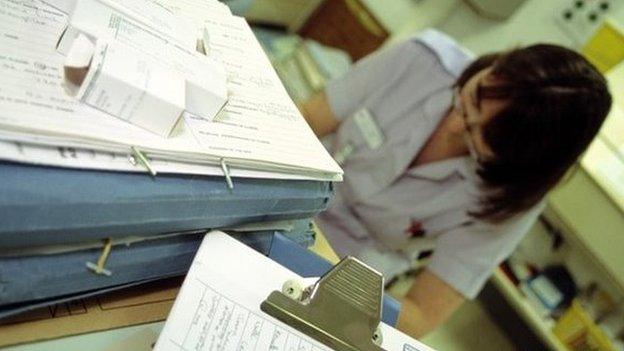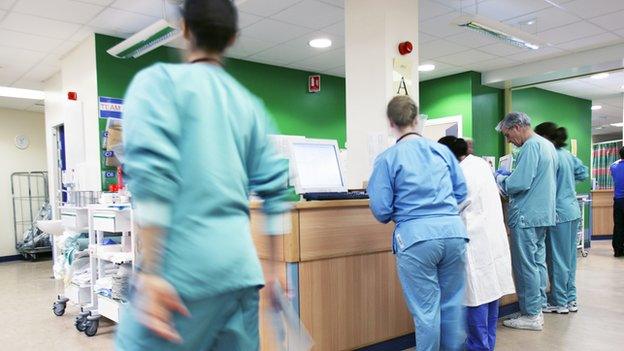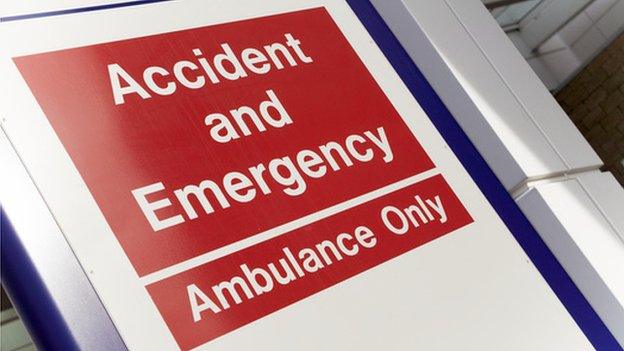More Scots waiting longer in A&E
- Published

New figures suggest Scotland's accident and emergency departments treated 91% of patients within four hours between October and December.
This compares to 94% in the previous quarter and is slightly worse than England's performance of 92.6%.
Scottish Government targets are for at least 95% of A&E patients to be seen, admitted, transferred or discharged within four hours.
NHS Lanarkshire had the worst average figure over the period - at 85.5%.
The figure for NHS Lanarkshire in November was just 83%.
The Scottish figure for October and November was 91.8% but that fell to 89.8% in December.
The numbers are below the overall performance in England, but above that in what are described as "core sites" in major cities south of the border.
In December, 89.9% of patients were seen within four hours in Scotland, compared to 90.2% in England and 81% in Wales.
At "core sites" in the same month, the performance was 88.6% in Scotland, 85.3% in England and 77.2% in Wales.
Shona Robison said tackling delayed discharge will help A&E meet its targets
Scottish Health Secretary Shona Robison said this winter had seen "unprecedented pressures" in hospitals.
In December, NHS Forth Valley (84.2%) and NHS Greater Glasgow and Clyde (84.5%) were the worst performers.
NHS Tayside was the best health board for waiting times with 99% seen within four hours.
There was a slight increase in attendances compared to previous years.
Key Points
The number of attendances at A&E services across Scotland over the past three years were
2014 - 1,645,200
2013 - 1,608,789
2012 - 1,642,816
During the final quarter of 2014, 4,028 patients spent more than eight hours in A&E and 517 spent more than 12 hours.
The statistics said 27% of attendances at A&E led to an admission to hospital.
New figures show more people are waiting longer for treatment in Scottish accident and emergency departments
The health secretary said: "Staff in Scotland's NHS have done a terrific job over what has been a very challenging time and I'd like to thank them for all their work as they cope with an increase in the number of patients and an increase in those being admitted.
"These factors have clearly impacted on performance and today's figures do not meet the demanding, world leading targets we have set and the standards that patients rightly demand.
"We are determined to improve performance, which is why we have been taking substantial action to ease pressure on the front door of the hospital, as well as concentrating on the timely discharge of patients."
Last month, the Scottish government announced £100m to help health boards and local authorities tackle bed blocking which it is hoped would help people move out of A&E and through the system.
'Ever-increasing demand'
Scottish Labour Leader Jim Murphy said the waiting time figures "expose the crisis in our NHS under the SNP".
He said: "Patients across Scotland are told regularly by SNP ministers that they should be grateful things aren't as bad as in England. Now we know that under the SNP things are even worse in Scotland. That's just not good enough and Scotland deserves better."
He said Scottish Labour planned to fund an extra 1,000 nurses in Scotland's NHS, using the money raised from a Mansion Tax on homes worth more than £2m if it was to get into power in Scotland.
Scottish Tory health spokesman Jackson Carlaw said: "Scottish Conservatives have long argued for 1,000 additional nurses to be the priority and a GP attached national health visiting services to be re-established along with a substantial investment and refocusing of GP practices.
"There is no justification for the SNP sneering at health services elsewhere in the UK when its own performance is rapidly failing before patients' eyes."
Scottish Liberal Democrat health spokesperson Jim Hume called on the Scottish government to take action to alleviate "pressure cooker conditions" at A&E units.
Theresa Fyffe, Scotland director of the Royal College of Nursing, said: "The longer waiting times at A&E are a symptom of a system that is struggling to cope with the ever-increasing demand it is under, so I'm glad the Scottish government is taking steps to address this."
Dr Peter Bennie, chairman of BMA Scotland, said, "For individual patients, waiting for treatment can be a particularly difficult and stressful time and it is important that those with the greatest clinical need receive appropriate care within a reasonable timescale.
"NHS staff are working incredibly hard to ensure that patients receive high quality, timely care, but they are struggling to cope. Pressure on NHS services is at a critical point and cracks are beginning to appear."

Analysis
From next month the NHS in Scotland will be moving to monthly reporting of A&E waiting times.
Scots have been getting less information about the performance of their local emergency department than their counterparts in the rest of the UK, meaning the new figures are the first waiting time figures since September.
In England, hospitals publish A&E performance statistics weekly and by hospital, allowing more scrutiny of the performance of individual hospitals.
In Northern Ireland the public is given monthly performance figures by hospital.
Wales publishes monthly statistics by health board rather than hospital.
In Scotland the public has been only told how the NHS has performed every three months, and at health board level.
Because waiting times are combined over a three-month period, the poor performance of particular hospitals on particular days is sometimes not apparent, and figures relating to the busy New Year period are not included in Tuesday's release.
- Published31 January 2015

- Published15 December 2014

- Published23 January 2015

- Published16 January 2015
